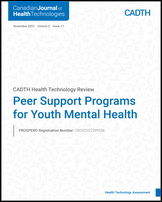| Conley et al. (2020)39; Hundert et al. (2021)40 |
All outcomes: Some concerns [?]
1.1 (PY).
Allocation sequence was random (participants were assigned via simple randomization methods such as coin toss, blindly shuffled pieces of paper, and online random number generator)
1.2 (NI).
No information about whether the allocation sequence was concealed until participants were enrolled and assigned to interventions.
1.3 (N).
There were no important differences between the groups at baseline that would suggest major problems in the randomization process.
|
All outcomes: low risk
2.1 (Y). Participants were aware of their assigned intervention.
2.2 (Y). Carers and people delivering the intervention were aware of the participants’ assigned intervention during the trial.
2.3 (N). There were no reported deviations from the intended intervention.
2.6 (Y). Appropriate analyses were used to estimate the effect of assignment to intervention (mITT analysis) All participants with assessment data irrespective of attending the sessions were included in the analysis.
|
All outcomes: High risk [?]
3.1 (N)
Across all outcomes. Data were not available for all randomized participants. Attrition rates were as below:
At post-intervention, n (%) HOP: 10 (15%), control: 0
At post-booster, n (%) HOP: 14 (22%), control 5 (9.2%)
At long-term follow-up, n (%): HOP: 13 (33%), control: 7 (19%)
3.2 (N). There was no evidence (e.g., sensitivity analyses) to indicate that the results were not biased by missing outcome data
3.3 (PY) it is possible that missingness in the outcome depended on its true value
3.4 (PY) it is possible that missingness in the outcome depended on its true value. Relatively high losses in the HOP group compared to control group could be due to perceived lack of efficacy.
|
All outcomes: High risk [+]
4.1 (PN; Y for self-efficacy) Across all outcomes except self-efficacy, the methods of measurement were probably appropriate. Self-efficacy was measured with a single item, whose validity was unclear.
4.2 (PN). It is not likely that the measurement or ascertainment of the outcome differed between intervention groups
4.3 (Y). Outcome assessors were aware of the intervention received by study participants.
4.4 (Y) The assessment of the outcome could have been influenced by knowledge of the intervention received. All outcomes were self-reported.
4.5 (PY). Across all outcomes, it is likely that assessment of outcomes was influenced by knowledge of the intervention received.
|
All outcomes: Some concerns [ND]
5.1 (NI). There was no information available to judge whether the data that produced the results were analyzed in accordance with a pre-specified analysis plan. (i.e., there was no mention of a trial protocol).
5.2 (NI). There was no information available to judge if the numerical results being assessed were likely to have been selected based on results from multiple eligible outcome measurements within the outcome domains.
5.3 (NI). There was no information available to judge if the numerical results being assessed were likely to have been selected based on the results from multiple eligible analyses of the data.
|
All outcomes: High risk [?]
|
| Mulfinger et al. (2018)50 |
All outcomes: Low risk
1.1 (PY). Allocation sequence was random (participants were assigned via block randomization at each site)
1.2 (PY) Allocation sequence was concealed until participants were enrolled and assigned to intervention. However, it was unclear whether the closed enveloped used were opaque, sequentially numbered, sealed, and opened after assignment.
1.3 1.3 (N).
There were no important differences between the groups at baseline. There were likely no problems in the randomization process.
|
All outcomes: Low risk
2.1 (Y). Participants were aware of their assigned intervention.
2.2 (Y). Carers and people delivering the intervention were aware of the participants’ assigned intervention during the trial.
2.3 (N). There were no reported deviations from the intended intervention.
2.6 (Y). Appropriate analyses were used to estimate the effect of assignment to intervention (an intention-to-treat analysis was conducted)
|
All outcomes: High risk [?]
3.1 (N)
Across all outcomes. Data were not available for all randomized participants. The attrition rates were 22% in both groups.
3.2 (N). There was no evidence (e.g., sensitivity analyses) to indicate that the results were not biased by missing outcome data.
3.3 (PY) it is possible that missingness in the outcome depended on its true value
3.4 (PY) it is possible that missingness in the outcome depended on its true value.
|
All outcomes: High risk [+]
4.1 (PN; PY for disclosure-related distress) Across all outcomes except disclosure-related distress, the methods of measurement were probably appropriate. Disclosure-related distress was measured with 4-item questionnaire, whose validity was unclear.
4.2 (PN). It is not likely that the measurement or ascertainment of the outcome differed between intervention groups
4.3 (Y). Outcome assessors were aware of the intervention received by study participants.
4.4 (Y) The assessment of the outcome could have been influenced by knowledge of the intervention received. All outcomes were self-reported.
4.5 (PY). Across all outcomes, it is likely that assessment of outcomes was influenced by knowledge of the intervention received.
|
All outcomes: Some concerns [ND]
5.1 (NI). There was no information available to judge whether the data that produced the results were analyzed in accordance with a pre-specified analysis plan. The trial was registered (NCT02751229) and outcomes were pre-specified, However, no published protocol was available.
5.2 (NI). There was no information available to judge if the numerical results being assessed were likely to have been selected based on results from multiple eligible outcome measurements within the outcome domains.
5.3 (NI). There was no information available to judge if the numerical results being assessed were likely to have been selected based on the results from multiple eligible analyses of the data.
|
All outcomes: High risk [?]
|
